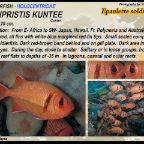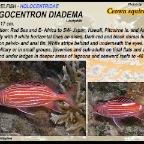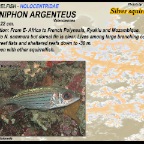Soldier and squirrelfish
SOLDIER AND SQUIRRELFISH - HOLOCENTRIDAE
There are around sixty-five different specimen of soldier and squirrelfish. As with most fish, the males are bigger than the females and all being nocturnal have quite big eyes. The squirrelfish has a bigger spine on the gill plates and the mouth is not pointed upwards. The base color is red and white and they all have large scales on the body. Soldierfish feed on zooplankton, while all squirrelfish feeds on worms, crustacean and small fish. Sometimes they make a kind of clicking sound when approached. This is not only because they try to chase you away, but also to communicate with the group. Length: 25 cm.Distribution: from the Red Sea to French Polynesia, S- Japan and Great Barrier Reef.Rear of the body silvery-white, small horizontal white stripe in front and above the gillplate. Always close to a shelter. Lives on outer reef slopes and dropoffs in areas with rich coral growth, down to -40 m.Abundant in the Red Sea and common in the west Indian Ocean and Micronesia.
Length: 30 cm.Distribution: from E- Africa to French Polynesia, S- Japan and Great Barrier Reef.Similar to N. argenteus but but front portion of spinous dorsal fin with dark red spot.Often among large branching Acropora corals around reef flats and sheltered reefs, down to -30 m. The most common Neoniphon in most shallow areas.Feeds primarily on small crabs. Length: 22 cm.Distribution: from E- Africa to French Polynesia, Ryukiu and Mozambique.Similar to N. sammara but dorsal fin is clear. Lives among large branching coralsaround reef flats and sheltered reefs down to -30 m.Often seen with other squirrelfish. Length: 32 cm.Distribution: from Red Sea & E- Africa to S.W- Japan, Tonga, New Caledonia, Vanuatu, and Australia.Red-brown and silvery-white horizontal stripes, dark streak on tail-base, rear dorsaland anal fin. Nocturnal, during the day hiding in wrecks, caves and cracks. Silty reefs, lagoons and coastal bays, from -1 to -84 m. Feeds on bentic crabs, shrimps and small fishes. The larvae grow-up pelagic. Length: 19 cm.Distribution: from Maldives to Philippines, Line Is, French Polynesia and Australia.Silvery-white and red stripes, white margin on anal and pelvic fins.Solitary or in loose groups, on reef flats and coastal reefs, lagoons and outer reef slopes, from -2 to -183 m. Length: 17 cm.Distribution: Red Sea and E- Africa to SW- Japan, Hawaii, Pitcairne Is. and Australia.Red body with 9 white horizontal lines on sides. Dark-red and black dorsal fin, white margin on pelvic- and anal fin. White stripe behind and underneath the eyes.Lives solitary or in small groups, juveniles and sub-adults on tidal flats and adults in caves and under ledges in deeper areas of lagoons and seaward reefs to -40 m.
Length: 25 cm.Distribution: from E- Africa to S- Japan, French Polynesia and New Caledonia.Orange-red, white tips on dorsal fin spines. All other fins except the dorsal fins, with a white margin. Gill-cover has a darker margin, goes down to the pectoral fins.In large aggregations in or near caves of drop-offs, from -3 to -80 m.Often some individuals swim upside down. Nocturnal, feeds on plankton.Length: 20 cm.Distribution: from E- Africa to SW- Japan, Hawaii, Fr. Polynesia and Australia.Orange-red, all fins with white-blue margined red fin tips. Small scales comparing other soldierfish. Dark red-brown band behind and on gill plate. Dark area in upper-part of eyes. During the day, close to shelter. Solitary or in loose groups, from the subtidal reef flats to depths of -35 m. In lagoons, coastal and outer reefs. Length: 45 cm. Distribution: from the Red Sea to French Polynesia, S- Japan and New South Wales. Deep body and large opercular spine. The largest and most common of all squirrelfish. During the day under ledges at reef flats, lagoons and seaward reefs, down to -122 m. Feeds primarily on crabs. Length: 27 cm.Distribution: Red Sea and E- Africa to SW- Japan, Samoa, and Australia.Deep red body, large scales and a fine white margin at the edge of the fins. A dark blotch in the eye and dark band on rear gill-cover.Lives solitary or in loose aggregations, during the day in or near a shelter.In lagoon, coastal and outer reefs to a depth of -35 m.























